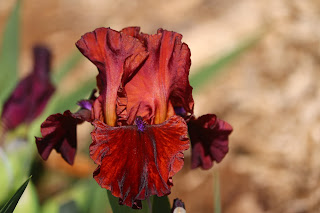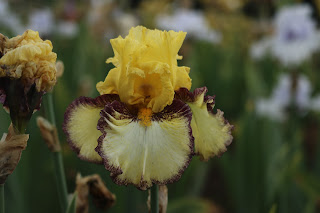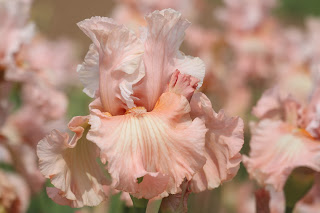By Sylvain Ruaud
Italian
iris hybridizers have in recent years done more interesting work, which is also
the case for French hybridizers. Augusto Bianco gradually elevated his business
to the rank of the most important in Europe, and has distinguished himself
several times in major competitions. People like Luigi Mostosi, Roberto Marucchi,
Lorena Montanari and Tiziano Dotto have been joined by young people eager to
find their place in the sun. At the commercial level, several new specialized
nurseries have opened up these last few years, which shows the growing appetite
of Italians for iris. We will try to explain how Italy procured its current
place in the world of irises.
 |
| 'Mew Pizzica"--image by Augusto Bianco |
At
first, that is to say in the years after the second world war, Italy created a
place quite original. Whilst elsewhere in the world hybridizers were becoming aware
of the need to register their varieties via AIS, in Italy it wasn’t the case.
Hybridization was the prerogative of some great aristocrats who saw it as a
hobby that could enhance the beauty of their gardens. Their creations were hard
to come by and they did not see the need to formalize their introductions via
registration, so it was an activity much more for fun than scientific or even
commercial. They were few, these gardeners who practiced hybridization. The
first was Mary Senni, a lady of American descent who married Count Giulio Senni
in 1907 and who, in the 30s to 50s, played a prominent role in public
dissemination of information on the progress of iris hybridization in Europe
and the United States through the articles she published in the Journal Il
Giardino Fiorito. Countess Senni was in close contact with the most important
breeders of the time, so that in 1931 a variety was dedicated to her by the
French breeder Millet. She practiced hybridization in her Roman garden and her
own varieties were favorably received by connoisseurs.
Later,
several other ladies followed suit. Starting with Gina Sgaravitti. She made
herself known with 'Beghina' which could be found in many European gardens. Of
Venetian origin, her marriage with Teresio Sgaravitti brought her to Rome where
she had to look after a large garden. Over the years, the garden became a sort
of nursery, with even a catalog exclusively devoted to iris. Flaminia Goretti,
wife of George Specht, dedicated her life to iris and it is thanks to her, in
large part, that the Florence Iris Garden, the International Competition and
the Italian Iris Society was created. Nita Radicati, wife of Stross, took part
in the creation of Iris Garden of Florence and directed the Review "Il
Giardino Fiorito". Together with her friend G.G. Bellia, she is behind the
creation of the San Bernardino di Trana Experimental Garden, near Turin, which
has since become the Giardino Botanico Rea, houses a superb collection of
historical irises and has just been rehabilitated. Those who are interested in
literature may know the Italian writer Italo Calvino, whose story "The
Baron Perched" has toured the world. Many people do not know that his
mother, Eva Mameli Calvino, made her name in the field of botany and, in particular,
in the field of irises. During the 30s - 50s she devoted a large number of
articles to them in the Journal Il Giardino Fiorito. She also experimented with
hybridization, even sending many of her new seedlings to the new Florence
Competition she helped launch. These ladies have remained very little known
outside the small circle of Italian iridophiles, and this situation is largely
due to the fact that, until recently, hybridization was, in Italy, considered a
hobby, practiced by intellectuals and others in high society.
To
make the connection between the beginning of iris hybridization and the modern
period, I only see Giuseppe Giovanni Bellia, a Turinese iris lover, and a part
time hybridizer. His unregistered introductions were spread from the 1960s to
the 1980s with varieties that remained confidential and only present in some
precious Italian collections.
The
emergence of Augusto Bianco, occurred in the early 1990s when we see iris
hybridization taking off.
Nevertheless,
Italian varieties have long been reserved for hobbiest for their country of
origin. They had trouble making themselves known beyond the Alps. My garden has
for a long time been proud to have many new Bianco irises, acquired through
friendly exchanges. Many of these irises were never recorded due to all kinds
of reasons (fragile plants, flowers without much interest, colors fading
rapidly in the sun...), but after this period the most successful iris then had
a European destiny, even global. The triumph of 'Vento di Maggio' (2011) at the
Florence competition in 2013 is the culmination of an already long career for
Bianco, marked by solid and elegant varieties.
 |
| 'Vento di Maggio'--image by Augusto Bianco |
The
awakening of Italy was first manifested in 1999 when 'Settimo Cielo' (V.
Romoli, 1999) took the lead over the American iris 'Swingtown' in the
Florentine competition.
Several
other breeders have also made themselves known by collecting additional awards
in the Florence competition.
Here
is the list, from 1996 to 2003:
•
Antonella
Affortunati : 'Samuele' ; 'Bagnolo' ; 'Battiloro' ; 'Capoliveri'
•
Mauro
Bertuzzi : 'Nebbia di Romagna' ; 'Recondita Armonia' (2) ; 'Fiore di Maggio' ;
'Macedonia' ; 'Notte di Lugo' ; 'Anemico'
•
Tiziano
Dotto : 'Egeo'
•
Stefano
Gigli : 'San Giovanni' ; 'Castelfranco' ; 'Viola di Nuovo' ; 'Ale Viola' (2) ;
'Amico Mio' ; 'Barbablu' ; 'Tramonto' ; 'Vinaccia'
•
Roberto
Marucchi : 'Libarna' ; 'Sorriso di Alice' ; 'Cheyenne my Dog' (2); 'Mattinata
Fiorentina'
•
Lorena
Montanari : 'Valeria Romoli' ; 'Fratello Sole' ; 'Ballerina Silhouette'
•
Luigi
Mostosi : 'Citta di Bergamo' ; 'Traffic Light’
•
Stefano
Paolin : 'Vymarna'
•
Valeria
Romoli : 'Buongiorno Aprile' ; 'Verde Luna' ; 'Celeste Aïda' ; 'Zefiro Rosa';
'Agrodolce' ; 'Luna Rossa'
•
Leonardo
Urbinati : 'Montefiore'
•
S.
Volani : 'Tabarro'
 |
| 'Ballet Silhouette'--image by Christina Cosi |
Since
2003, Italian breeders have expanded in numbers and established themselves well
in the competition for the Fiorino d'Or
- Mauro
Bertuzzi (see above) : 'Tenue Tenerezza' ; 'Aria di Maggio'
- Angelo
Bolchi : 'Lingua di Drago' ; 'Voglio Tempo'
- Davide
Dalla Libera : seedling DAL 758-4/7 ; seedling DAL 08-4/2 ; 'Spicy Violet' ;
'Red Surge'
- Tiziano
Dotto (see above) : 'Sara' ; 'Esabella' ; 'Baba Jaga' ; 'Almast'
- Angelo
Garanzini : 'Pietra Focaia' ; 'Anima Cara' (3) ; 'Rubizzo' ; 'Anima Triste'
- Simone
Luconi : 'Lucomone I°' ; 'Donella G.'
- Roberto
Marucchi (see above) : seedling U 39-1
- Lorena
Montanari (see above) : seedling 7/06 A ; 'Come un Uragano' ; 'La Vita e'
Bella' ; 'Buon Compleano' ; 'Il Canto delle Sirene'
- Valeria
Negri : 'Notte Profumata'
- Stefano
Paolin (see above) : 'Canto del Cherubino'
For
a long time, confined to their Florentine competition, the Italian breeders
have only recently tried to make themselves known internationally, and their
irises have been brilliantly represented elsewhere in Europe. This is how
Angelo Garanzini's 'Cielo Alto' ranked second in Paris in 2015.
The
long list above proves that in Italy, now, irises have reached an important
level. And this is confirmed by the fact that several new nurseries have opened
recently, which shows that it is not only professionals (or
semi-professionals), but that the general public is also interested.
Nevertheless,
it remains a good idea to suggest that all hybridizers take systematic
registration of new varieties to heart, as many of the ones mentioned here have
still remained in anonymity.
(1)
See my previous column.
(2)
Varieties receiving an additional award (1996/2012):
1997
= 'Piero Bargellini'
1998
= 'Te alla Pesca'
2000
= 'Rosa Vanitosa'
2001
= 'Marcel Hayat'
2003
= 'Bianca Micheletta';
2004
= 'Dolce Acqua'; 'Dragone'
2005
= 'Tango Bond'
2009
= 'Certosino'; 'Ci Sei';
2011
= 'Tenebroso'; 'Sahariana'
Subsequently
the following varieties have been awarded:
2017
= 'Tropical Delizia'; 'Campo di Marte'; 'Rosso di Sera'
2018
= 'Mille Tre'; 'Mille Due'; 'Valdarno'; 'Long Play'.
 |
| 'Long Play'--image by Augusto Bianco |
(3)
Winner of the "Premio Firenze"
.JPG)


.JPG)
.JPG)
.JPG)
.JPG)

.JPG)

.JPG)
.JPG)
.JPG)
.JPG)



























